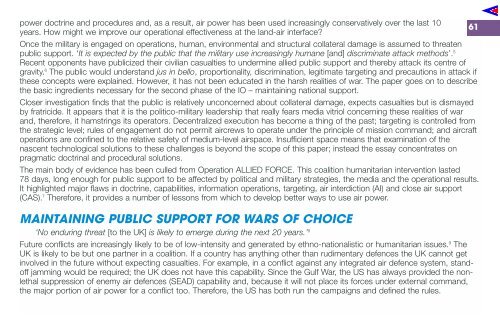Volume 5 No 2 - Royal Air Force Centre for Air Power Studies
Volume 5 No 2 - Royal Air Force Centre for Air Power Studies
Volume 5 No 2 - Royal Air Force Centre for Air Power Studies
Create successful ePaper yourself
Turn your PDF publications into a flip-book with our unique Google optimized e-Paper software.
power doctrine and procedures and, as a result, air power has been used increasingly conservatively over the last 10<br />
61<br />
years. How might we improve our operational effectiveness at the land-air interface?<br />
Once the military is engaged on operations, human, environmental and structural collateral damage is assumed to threaten<br />
public support. ‘It is expected by the public that the military use increasingly humane [and] discriminate attack methods’. 5<br />
Recent opponents have publicized their civilian casualties to undermine allied public support and thereby attack its centre of<br />
gravity. 6 The public would understand jus in bello, proportionality, discrimination, legitimate targeting and precautions in attack if<br />
these concepts were explained. However, it has not been educated in the harsh realities of war. The paper goes on to describe<br />
the basic ingredients necessary <strong>for</strong> the second phase of the IO – maintaining national support.<br />
Closer investigation finds that the public is relatively unconcerned about collateral damage, expects casualties but is dismayed<br />
by fratricide. It appears that it is the politico-military leadership that really fears media vitriol concerning these realities of war<br />
and, there<strong>for</strong>e, it hamstrings its operators. Decentralized execution has become a thing of the past; targeting is controlled from<br />
the strategic level; rules of engagement do not permit aircrews to operate under the principle of mission command; and aircraft<br />
operations are confined to the relative safety of medium-level airspace. Insufficient space means that examination of the<br />
nascent technological solutions to these challenges is beyond the scope of this paper; instead the essay concentrates on<br />
pragmatic doctrinal and procedural solutions.<br />
The main body of evidence has been culled from Operation ALLIED FORCE. This coalition humanitarian intervention lasted<br />
78 days, long enough <strong>for</strong> public support to be affected by political and military strategies, the media and the operational results.<br />
It highlighted major flaws in doctrine, capabilities, in<strong>for</strong>mation operations, targeting, air interdiction (AI) and close air support<br />
(CAS). 7 There<strong>for</strong>e, it provides a number of lessons from which to develop better ways to use air power.<br />
MAINTAINING PUBLIC SUPPORT FOR WARS OF CHOICE<br />
‘<strong>No</strong> enduring threat [to the UK] is likely to emerge during the next 20 years.’ 8<br />
Future conflicts are increasingly likely to be of low-intensity and generated by ethno-nationalistic or humanitarian issues. 9 The<br />
UK is likely to be but one partner in a coalition. If a country has anything other than rudimentary defences the UK cannot get<br />
involved in the future without expecting casualties. For example, in a conflict against any integrated air defence system, standoff<br />
jamming would be required; the UK does not have this capability. Since the Gulf War, the US has always provided the nonlethal<br />
suppression of enemy air defences (SEAD) capability and, because it will not place its <strong>for</strong>ces under external command,<br />
the major portion of air power <strong>for</strong> a conflict too. There<strong>for</strong>e, the US has both run the campaigns and defined the rules.
















